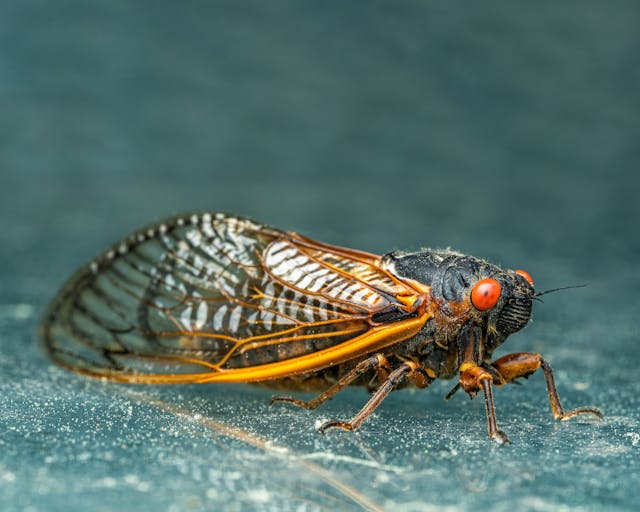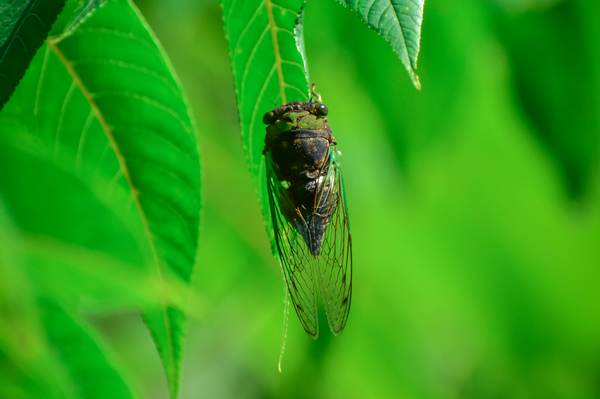Something exciting is happening this year in the insect world, and it’s all to do with cicadas. You may have seen some news articles about the rare double emergence of 2 cicada broods, but did you know that this is the first time since 1803 (the year of the Louisiana Purchase, when Thomas Jefferson was president, and there were only 17 states in the U.S.) that brood XIX & XIII will co-emerge? And though that’s definitely the headline for the excitement around this year’s special cicada happenings, it’s not the only noteworthy occurrence this year. For cicada fans, 2024 also brings with it the chance to see all 7 periodical cicada species as adults in the same year, an event that won’t happen again until 2037.
But what does all this actually mean? And is there cause for concern for us here in Texas? Keep reading to find out all about cicadas and what you can expect from this historic event.

What Do Cicadas Look Like?
Like most insects, cicadas can vary in appearance depending on their species. However, unlike most insects, they also vary in appearance based on whether they are annual or periodical (more on this in a moment). In general, cicadas are about 0.5 inches wide and between 1 and 1.625 inches long, with the annual group being on the larger side. They are all stout, have bulging eyes, short antennae, and semi-transparent wings that are longer than their abdomen and are held tent-like over their bodies. Though their coloring depends on species, they tend to be brown, green, or black, and have white markings; periodical cicadas usually have reddish eyes and orange veins in their wings.
Nymphs of this pest have the same look as the adults, except they are dark brown and wingless. You can tell if you’ve had one of these young cicadas in your area if you find a pale, empty husk in the shape of a cicada clinging to your trees or your house; this husk is the remnants of the final stage a cicada goes through before becoming an adult.
What Are Cicada Broods?
Before we can discuss what a cicada brood is, you first need to understand the difference between periodical and annual cicadas, and in order to do that, you need to first look at the life cycle of all cicadas. The basic life cycle goes like this: female cicadas lay eggs in trees; after 6 weeks or so, small nymphs hatch and drop to the ground where they burrow into the soil; while underground the nymphs will molt through several stages; eventually, when they have reached their final nymph stage and the weather is right, they will emerge from the ground and climb up the nearest object (usually a tree), and when they have reached maturity they will molt and become an adult. Adults live around 5 or 6 weeks and spend most of their energy mating in order to continue this life cycle. It’s in the time spent underground that we see the big difference between periodical and annual cicadas.
Annual cicadas have life cycles of 2 to 5 years, meaning that they only emerge from the ground and become adults every 2 to 5 years. While that may make you start to question why we see these pests every year in Texas, it’s because there are around 159 cicada species in the U.S. and Canada, about 39 of which are in Texas, and they aren’t all on the same emergence schedule.
Periodical cicadas have life cycles that last either 13 or 17 years; that means that they only emerge as adults once every 13 or 17 years!
A cicada “brood” is a term used to group all periodical cicadas of the same life cycle that will emerge in a specific year, it is not the same as a cicada species. To showcase this distinction, there are 7 periodical cicada species, but there are 12 broods of 17-year cicadas and 3 broods of 13-year cicadas. The 15 unique cicada broods are designated by Roman numerals.

Where Will The Double Emergence of Cicada Broods Appear?
The two cicada broods emerging this year are Brood XIII (a 17-year brood) and Brood XIX (a 13-year brood). Brood XIII will be found in Illinois, Wisconsin, Indiana, Michigan, and Iowa. Brood XIX will be found in Illinois, Missouri, Iowa, Arkansas, Oklahoma, Louisiana, Mississippi, Alabama, Georgia, Kentucky, Tennessee, Virginia, North Carolina, South Carolina, and possibly even east Texas. Though both broods can be seen in Illinois, their territories barely overlap, with the greatest possibility of a “double” density of cicadas around Springfield, IL. This means that though it’s a very exciting time for cicada fans, here in north Texas we are unlikely to notice a drastic uptick in the number of these pests flying around our yards from any other year, though we may notice a few with reddish eyes hanging around.

Where Will You Find Cicadas?
Cicadas can be found the world over, but interestingly, periodical cicadas are only found in the U.S. and are most common in the central and eastern regions of our country. Fortunately, these pests only choose to live outdoors, specifically on or near trees and other plants; this means that though a stray one might find its way into your home, it won’t start its family alongside your family.
What is a Cicada “Song”?
A cicada “song” refers to the whirring noise we all associate with the emergence of these pests in spring and summer. Though we might quickly get irritated with this constant buzz, it is in fact a love song from male cicadas (yes, only males make this distinct sound) trying to attract a mate (though occasionally it can also be a defense mechanism). They make their particular sound (different species have different “songs”) by vibrating special structures on their abdomen, the sound of which is amplified by the large air sac that comprises most of their abdomen.
If you’ve ever felt that this “song” is uncomfortably loud, you’re not alone, and with good reason! A cicada “song” can reach 90 decibels (about the same as a lawnmower) and when a whole group gets going at once, that can quickly get out of hand.

Are Cicadas Dangerous?
The answer to this question is a bit ‘yes,’ but mostly ‘no.’ Fortunately, the ‘yes’ part is mostly specific to young trees. Cicadas are known to damage young trees in two main ways: first, when females create slits in branches in order to lay their eggs, and second when nymphs (which mature underground) feed on the roots of the young tree. These pests are also not ideal to be around your pets, not because they will directly harm them, but because if your pet were to eat one, it could cause digestive issues and discomfort, and the cicada wings could potentially lodge in your pet’s throat. Though these insects do not pose any danger to humans, they can mess with some of your stuff; specifically, they can land in pools and hot tubs and end up clogging and burning out the filters for these items. So, all in all, they don’t pose a significant danger, but they can sure be quite a nuisance.

Can You Prevent Cicadas?
Though there is no way to fully prevent these pests from finding their way into your yard, there are a few things you can do to help protect your trees and property and help you keep your sanity amongst these noisy insects.
- Keep trees and shrubs pruned and trimmed
- Clean up any dead cicadas you find (they will not only emit an odor as they decay, their carcasses can attract other pest issues to your property)
- Before cicadas emerge, you can protect young trees by utilizing foil barrier tape and netting
- Keep pools and hot tubs covered when not in use
- Keep window/door screens in good condition and be sure to use them
- Cover any patio furniture located under trees (to keep cicada excrement from ending up on it)
- Do your yard work in the early morning or late evening when cicadas are least active (it’ll be much quieter then!)
What To Do If You See Cicadas In And Around Your Home?
While seeing (and hearing) cicadas isn’t exactly the best part of summer for most people, it’s also not the worst (fire ants, I’m looking at you), so often you can simply wait for these pests to fade away as cicada season wraps up in mid-to-late-summer. However, if you find yourself surrounded by droves of these insects and their constant din, give The Bug Dude a call at 817-354-5350 and let our technicians set up a treatment plan that will help get you some peace and quiet from these pests.
While 2024 is set to be a historic year for cicadas, that doesn’t mean it needs to be a memorable year for your battle with bugs. At the first sign of a pest problem give The Bug Dude a call at 800-310-BUGS (2847) and let us help you make your 2024 extraordinary (for something other than swarms of insects).
Further Reading:
“Dog-Day Cicada” – Field Guide to Common Texas Insects, Texas A&M AgriLife Extension
“Summer is here….and so are cicadas!” – Wizzie Brown, Extension Program Specialist- IPM with Texas A&M AgriLife Extension Service
“Cicadas in Texas” – Taiwo Victor, A-Z Animals
“Broods” – University of Connecticut, Biodiversity Research Collections, Periodical Cicada Information Pages
“The 2024 Periodical Cicada Emergence” – University of Connecticut, Biodiversity Research Collections, Periodical Cicada Information Pages
“Here come the cicadas!” – Glenn Rosenholm, Eastern Region, USDA Forest Service
“What You Should Know About April’s Cicada ‘Double Emergence'” – Luke Henkhaus, Texas A&M University Division of Marketing & Communications





